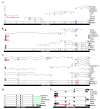In Silico characterization of phosphorylase kinase: evidence for an alternate intronic polyadenylation site in PHKG1
- PMID: 17692548
- PMCID: PMC2706538
- DOI: 10.1016/j.ymgme.2007.06.015
In Silico characterization of phosphorylase kinase: evidence for an alternate intronic polyadenylation site in PHKG1
Abstract
Phosphorylase kinase (PhK), the key enzyme that regulates glycogenolysis, has traditionally been thought to be expressed predominantly in muscle and liver. In this study, we show by two different database searches (Expressed Sequence Tag and UniGene) that PhK gene expression occurs in at least 28-36 different tissues, and that the genes encoding the alpha, beta, and gamma subunits of PhK undergo extensive transcriptional processing. In particular, we have identified exon 6 of PHKG1 as a 3' composite terminal exon due to the presence of a weak polyadenylation and cleavage site in intron 6. We have verified biochemically that transcriptional processing of PHKG1 does occur in vivo; mRNA corresponding to the alternate variant is expressed in skeletal muscle, brain, heart, and tongue. In silico translation of this mRNA yields a PhK gamma subunit that contains the first 181 residues of the protein, followed by an additional 21 amino acids. The implication of this alternate processing is discussed within the context of gamma catalysis and regulation.
Figures



Similar articles
-
Muscle glycogenosis with low phosphorylase kinase activity: mutations in PHKA1, PHKG1 or six other candidate genes explain only a minority of cases.Eur J Hum Genet. 2003 Jul;11(7):516-26. doi: 10.1038/sj.ejhg.5200996. Eur J Hum Genet. 2003. PMID: 12825073
-
Liver glycogenosis due to phosphorylase kinase deficiency: PHKG2 gene structure and mutations associated with cirrhosis.Hum Mol Genet. 1998 Jan;7(1):149-54. doi: 10.1093/hmg/7.1.149. Hum Mol Genet. 1998. PMID: 9384616
-
X-linked liver phosphorylase kinase deficiency is associated with mutations in the human liver phosphorylase kinase alpha subunit.Am J Hum Genet. 1995 Feb;56(2):381-7. Am J Hum Genet. 1995. PMID: 7847371 Free PMC article.
-
Molecular genetics of phosphorylase kinase: cDNA cloning, chromosomal mapping and isoform structure.J Inherit Metab Dis. 1990;13(4):435-41. doi: 10.1007/BF01799500. J Inherit Metab Dis. 1990. PMID: 2122110 Review.
-
Phosphorylase kinase: the complexity of its regulation is reflected in the complexity of its structure.Front Biosci. 1999 Sep 15;4:D618-41. doi: 10.2741/brushia. Front Biosci. 1999. PMID: 10487978 Review.
Cited by
-
Clinical and Molecular Variability in Patients with PHKA2 Variants and Liver Phosphorylase b Kinase Deficiency.JIMD Rep. 2017;37:63-72. doi: 10.1007/8904_2017_8. Epub 2017 Mar 12. JIMD Rep. 2017. PMID: 28283841 Free PMC article.
-
Discovery of novel human transcript variants by analysis of intronic single-block EST with polyadenylation site.BMC Genomics. 2009 Nov 12;10:518. doi: 10.1186/1471-2164-10-518. BMC Genomics. 2009. PMID: 19906316 Free PMC article.
-
Lung adenocarcinoma-derived vWF promotes tumor metastasis by regulating PHKG1-mediated glycogen metabolism.Cancer Sci. 2022 Apr;113(4):1362-1376. doi: 10.1111/cas.15298. Epub 2022 Feb 20. Cancer Sci. 2022. PMID: 35150045 Free PMC article.
-
Elucidation of the molecular mechanisms underlying adverse reactions associated with a kinase inhibitor using systems toxicology.NPJ Syst Biol Appl. 2015 Sep 28;1:15005. doi: 10.1038/npjsba.2015.5. eCollection 2015. NPJ Syst Biol Appl. 2015. PMID: 28725458 Free PMC article.
-
CpG island methylation profiling in human salivary gland adenoid cystic carcinoma.Cancer. 2011 Jul 1;117(13):2898-909. doi: 10.1002/cncr.25818. Epub 2011 Jan 11. Cancer. 2011. PMID: 21692051 Free PMC article.
References
-
- Pickett-Gies CR, Walsh DA. In: The Enzymes. 3. Boyer PDaKEG., editor. Vol. 17. Orlando: Academic Press; 1986. pp. 395–459.
-
- Brushia RJ, Walsh DA. Phosphorylase kinase: the complexity of its regulation is reflected in the complexity of its structure. Front Biosci. 1999;4:D618–41. - PubMed
-
- Geng Y, et al. Mapping of a liver phosphorylase kinase alpha-subunit gene on the mouse X chromosome. Genomics. 1993;15(1):191–3. - PubMed
Publication types
MeSH terms
Substances
Grants and funding
LinkOut - more resources
Full Text Sources

